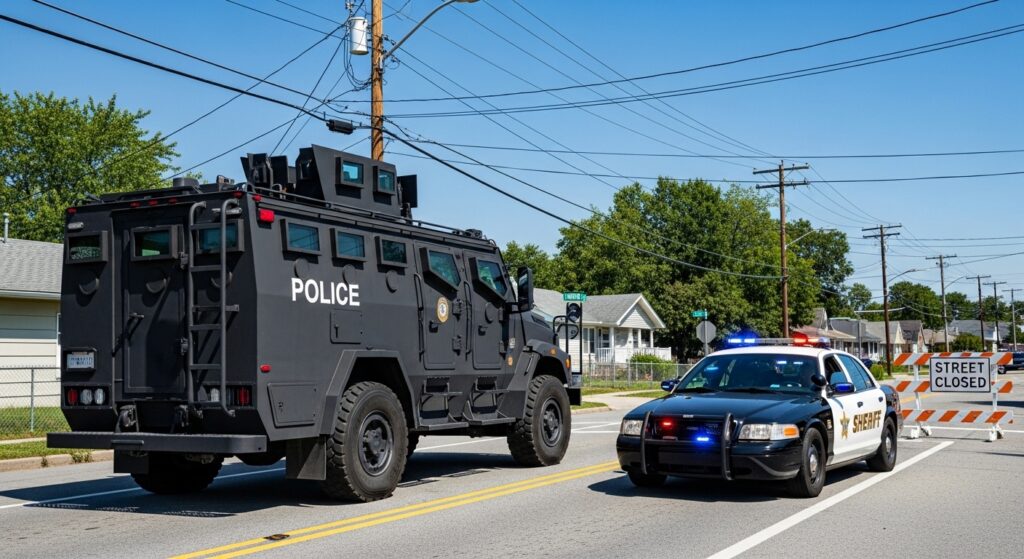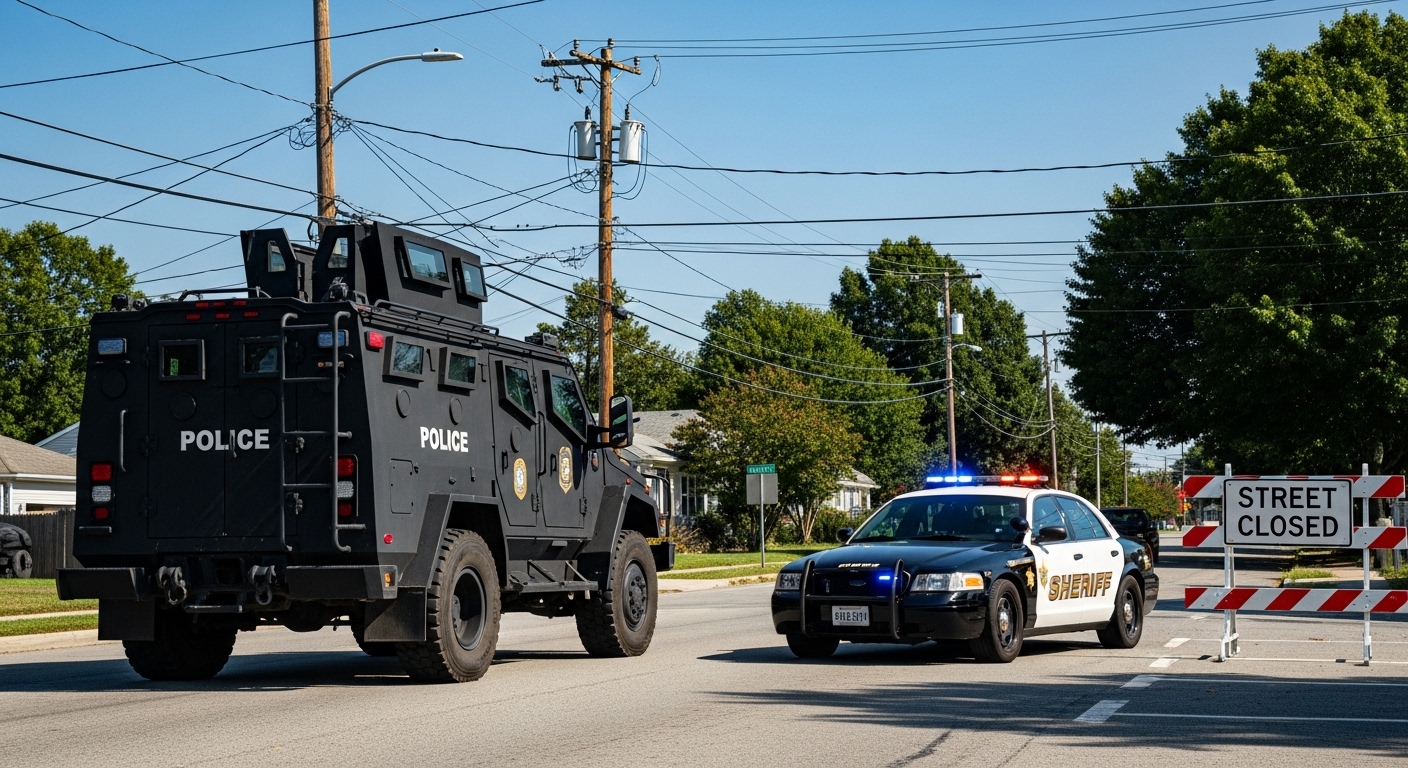Tragedy unfolds: A targeted sniper attack leaves two Firefighters in Idaho dead during a wildfire response near Coeur d’Alene. Learn how this ambush impacts brave emergency responders across the state.
Table of Contents
Two Firefighters in Idaho: Ambush Highlights Dangers to First Responders
Firefighters in Idaho Coeur d’Alene, Idaho – A solemn cloud hangs over northern Idaho after a harrowing incident on Sunday, June 29, 2025, when firefighters responding to a blaze near Coeur d’Alene were tragically ambushed in a sniper attack. The assault, which officials describe as a “heinous direct assault,” resulted in the deaths of two firefighters and injuries to at least one other individual. The unfolding situation on Canfield Mountain has underscored the severe and unpredictable dangers faced by Firefighters in Idaho and across the nation, as they bravely confront not only natural disasters but also the alarming threat of targeted violence.
The incident began around 1:21 p.m. local time when fire crews were dispatched to a wildfire on Canfield Mountain. Just over 40 minutes later, reports emerged that these dedicated professionals were under fire. Kootenai County Sheriff Robert Norris confirmed that his deputies were “actively taking sniper fire as we speak” during an afternoon news conference, highlighting the immediate and ongoing danger. The use of “high-powered rifles” and the attackers’ ability to blend into the “heavy brush” of the rugged terrain suggested a planned and coordinated assault, raising concerns about multiple perpetrators.
A Community Under Siege: Firefighters in Idaho
As news of the ambush spread, law enforcement agencies in the Coeur d’Alene area moved swiftly to evacuate the popular hiking destination. Hikers who had been enjoying the trails on Canfield Mountain were urged to leave the area, while residents were advised to shelter indoors. The gravity of the situation was evident in Sheriff Norris’s caution that the operation to subdue the attacker or attackers could “last multiple days” if the suspects were not stopped quickly. This protracted engagement further complicated efforts to contain the original fire, which continued to burn, adding another layer of risk to the already perilous environment.
Kim Anderson, a spokeswoman for Kootenai Health hospital system, confirmed the tragic toll: two fatalities and one person brought in with injuries from the shooting. While details on the injured individual’s condition were not immediately available, the news sent shockwaves through the community, a stark reminder of the sacrifices made by first responders.
The Landscape of Danger: Canfield Mountain and its Significance Targeted Sniper
Canfield Mountain, situated on the eastern outskirts of Coeur d’Alene, is a diverse area encompassing both public and private lands. Its network of trails through steep mountain terrain makes it a favored spot for outdoor enthusiasts, including hikers, mountain bikers, and motorcyclists. This popularity, however, also presents challenges for emergency response, as the vast and rugged landscape can provide cover for those with hostile intentions.
Graham Christensen, past president of the Lake City Trail Alliance, expressed profound shock at the attack. He noted that the Coeur d’Alene Fire Department regularly performs essential brush clearing and fire suppression in the area, and he could not recall a naturally caused wildfire there in two decades. His sentiment that the area had “always felt so safe” echoed the disbelief of many residents, underscoring the unprecedented nature of this ambush.
Eyewitness Accounts and the Resilient Spirit of Idaho
Brian Hadley, who had been riding dirt roads on Canfield Mountain to train for a mountain-biking race, recounted a chilling experience. A neighbor’s call about the fire around 1:35 p.m. prompted him to turn back. As he descended the mountain, he distinctly heard “three gunshots in quick succession.” Upon reaching the parking lot, law enforcement officers immediately ordered him out of the area. Hadley’s personal encounter with the sound of gunfire brought the reality of the ambush into sharp focus for him and for those he shared his story with.
His observation of smoke drifting over his roof Sunday evening, despite the immediate dangers, was particularly unnerving. Recent dry conditions in northern Idaho have significantly elevated the wildfire danger, making effective fire suppression efforts all the more critical. The ongoing gunfire severely hampered the ability of Firefighters in Idaho to address the initial blaze, creating a compounding crisis.
Sheriff Norris emphasized the immediate priority: developing a plan to “suppress the capability of the shooter or shooters to open fire.” Only once that control was established could efforts resume to safely remove remaining individuals from the mountain and continue with fire suppression. This methodical approach highlighted the extreme tactical challenges presented by the active shooter scenario.

Interagency Response and Statewide Concern: Firefighters in Idaho
The gravity of the situation quickly escalated to involve state and federal resources. The F.B.I. confirmed their presence on the scene, providing crucial technical teams and tactical support to the local authorities. This multi-agency response is typical for incidents of this magnitude, leveraging diverse expertise to address complex threats.
Idaho Governor Brad Little took to social media to urge the public to stay away from the affected area, emphasizing the danger to both civilians and emergency personnel. His statement, “This is a heinous direct assault on our brave firefighters. I ask all Idahoans to pray for them and their families as we wait to learn more,” encapsulated the statewide shock and concern.
Kootenai County Emergency Management issued an alert, instructing residents to shelter in place and avoid the vicinity of Canfield Mountain Trailhead and Nettleton Gulch Road, later expanding the alert to include an area south of Hayden Lake Road and east of 15th Street. These advisories were vital in ensuring public safety while the active situation unfolded.
The Broader Context: Firefighter Fatalities and Attacks on First Responders
While the immediate focus remains on the situation in Idaho, this incident tragically highlights broader trends concerning the safety of Firefighters in Idaho and across the United States. Firefighting is inherently dangerous, and line-of-duty deaths occur annually due to various causes, including stress/overexertion, vehicle collisions, and fireground operations.
According to data from the U.S. Fire Administration (USFA) and the National Fire Protection Association (NFPA), in 2024, there were 62 firefighter fatalities in the United States, a 31% decrease from 90 fatalities in 2023. Of the 62 deaths in 2024, 51 occurred while firefighters were on duty. The leading cause of death was overexertion or strain, accounting for 65% of all fatalities, with heart attacks making up nearly half of those. Fireground operations accounted for 20 deaths in 2024, a decrease from 32 in 2023. This Idaho incident, however, represents a different and alarming type of threat – a deliberate, armed attack.
Firefighters in Idaho
While specific comprehensive national statistics on “attacks” or “ambushes” on firefighters are not as readily available as general line-of-duty deaths, incidents of violence against emergency personnel are a recognized concern. Emergency medical services (EMS) personnel and law enforcement officers also face significant risks of assault and ambush. For example, workplace violence is a growing problem for healthcare providers, including those in emergency departments, with studies indicating high percentages of verbal and physical violence experienced by staff. Ambush attacks on first responders, though less frequent than other forms of line-of-duty fatalities, are particularly insidious due to their unpredictable nature and the element of surprise. They often involve a calculated plan and pose immense psychological and physical risks.
Demographics and Community Profile of Kootenai County: Firefighters in Idaho
Understanding the context of Kootenai County can offer some insights, though it’s crucial to avoid drawing direct causal links to such an isolated and extreme event. Kootenai County, Idaho, is a growing area. As of July 1, 2024, its population was estimated at 188,323, representing a 9.9% increase since April 1, 2020. Coeur d’Alene, the county’s largest city, has an estimated population of approximately 58,195.
In terms of demographics, Kootenai County is predominantly White alone, non-Hispanic or Latino, at 88.9%. White alone (including Hispanic or Latino) accounts for 93.9% of the population. Other racial groups make up smaller percentages: Black alone (0.5%), American Indian and Alaska Native alone (1.3%), Asian alone (1.1%), Native Hawaiian and Other Pacific Islander alone (0.2%), and Two or More Races (3.0%). Hispanic or Latino individuals comprise 5.9% of the total population. These statistics reflect a relatively homogenous demographic profile for the region.
The median household income in Kootenai County from 2019-2023 was $77,034, and the percentage of persons in poverty was 9.3%. The area is known for its natural beauty and outdoor recreational opportunities, which draw both residents and tourists. The crime rate in Coeur d’Alene, like many communities, is tracked by the local police department, with reports available on their website. While a general increase in violent crime across some major US cities has been noted in first-quarter comparisons for 2025 versus 2024, local specifics for Coeur d’Alene regarding this particular type of targeted attack are not indicative of broader trends.
The Psychological Toll on First Responders
Beyond the immediate physical danger and tragic loss of life, incidents like the Coeur d’Alene ambush have profound psychological impacts on first responders. Firefighters, paramedics, and law enforcement officers are routinely exposed to traumatic events, but a targeted attack adds an entirely different dimension of stress and trauma. The element of surprise, the deliberate intent to harm, and the feeling of being vulnerable in a situation where they are typically the ones providing aid can lead to severe psychological distress.
Post-traumatic stress disorder (PTSD), anxiety, depression, and a reduced sense of safety are common after such incidents. The “fire service family” is often a strong support system, but the collective trauma experienced by a department after losing colleagues in such a manner can be immense. Providing robust mental health support and resources for these individuals is crucial for their long-term well-being and their ability to continue serving their communities effectively.
Facing a Challenging Wildfire Season: Firefighters in Idaho
Adding to the immediate crisis, Idaho is bracing for what meteorologists are predicting will be a severe fire season in 2025, lasting through at least September. The National Interagency Fire Center (NIFC) indicates that lower elevations in Idaho face the greatest risk due to a combination of a wet winter followed by a dry spring and summer. This has led to abundant grass growth and increased brush, providing significantly more fuel for potential wildfires.
This forecast creates a concerning backdrop for the recent ambush. The ability of Firefighters in Idaho to effectively combat wildfires is paramount, and any threat that compromises their safety or hinders their operations has far-reaching consequences for the state’s natural resources and public safety. The ongoing fire on Canfield Mountain, left largely unaddressed due to the active shooter situation, serves as a stark illustration of this interconnected challenge.
The Path Forward:Firefighters in Idaho
As the manhunt for the perpetrator or perpetrators continues, the resolve of the community and its first responders remains unwavering. The collaborative efforts of the Kootenai County Sheriff’s Office, the Coeur d’Alene Fire Department, the F.B.I., and other agencies demonstrate a unified front against this unprecedented act of violence. The prayers and support from Governor Little and Idahoans across the state reflect a deep appreciation for the bravery and sacrifice of their firefighters.
This tragic event serves as a somber reminder of the evolving threats faced by those who dedicate their lives to protecting others. It highlights the critical need for continued vigilance, enhanced safety protocols, and comprehensive support systems for Firefighters in Idaho and all first responders, ensuring they can continue their vital work with the utmost safety and resilience. The investigation will undoubtedly shed more light on the motivations behind this heinous act, but the immediate priority remains the safety of the community and bringing those responsible to justice.
